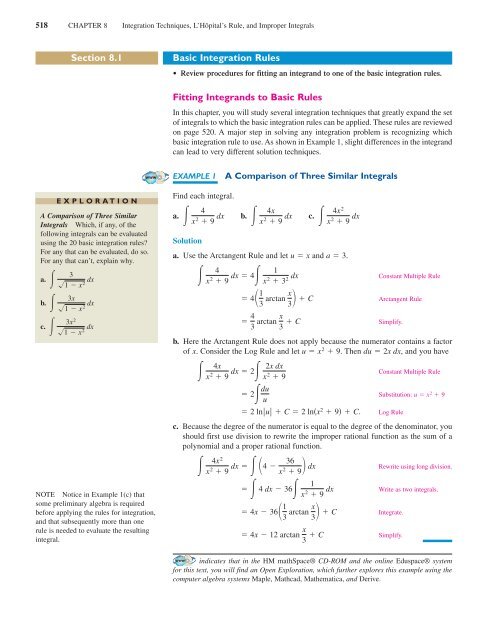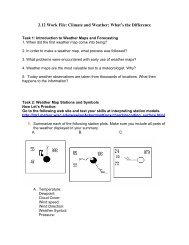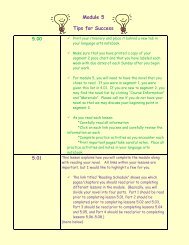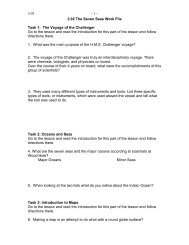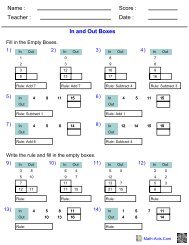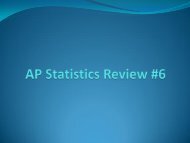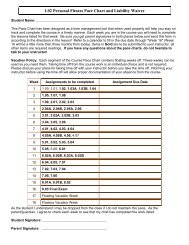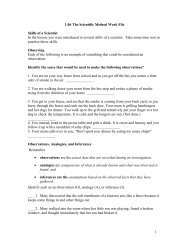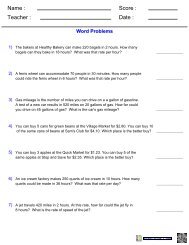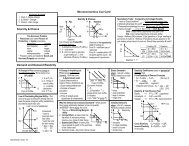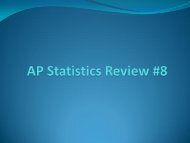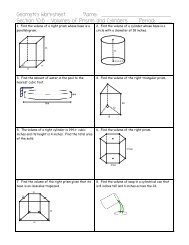Section 8.1 Basic Integration Rules Fitting Integrands to Basic Rules
Section 8.1 Basic Integration Rules Fitting Integrands to Basic Rules
Section 8.1 Basic Integration Rules Fitting Integrands to Basic Rules
Create successful ePaper yourself
Turn your PDF publications into a flip-book with our unique Google optimized e-Paper software.
332460_0801.qxd 11/2/04 3:04 PM Page 518518 CHAPTER 8 <strong>Integration</strong> Techniques, L’Hôpital’s Rule, and Improper Integrals<strong>Section</strong> <strong>8.1</strong><strong>Basic</strong> <strong>Integration</strong> <strong>Rules</strong>• Review procedures for fitting an integrand <strong>to</strong> one of the basic integration rules.<strong>Fitting</strong> <strong>Integrands</strong> <strong>to</strong> <strong>Basic</strong> <strong>Rules</strong>In this chapter, you will study several integration techniques that greatly expand the se<strong>to</strong>f integrals <strong>to</strong> which the basic integration rules can be applied. These rules are reviewedon page 520. A major step in solving any integration problem is recognizing whichbasic integration rule <strong>to</strong> use. As shown in Example 1, slight differences in the integrandcan lead <strong>to</strong> very different solution techniques.EXAMPLE 1A Comparison of Three Similar IntegralsEXPLORATIONA Comparison of Three SimilarIntegrals Which, if any, of thefollowing integrals can be evaluatedusing the 20 basic integration rules?For any that can be evaluated, do so.For any that can’t, explain why.a.31 x dx 23xb.1 x dx 23xc. 21 x dx 2NOTE Notice in Example 1(c) thatsome preliminary algebra is requiredbefore applying the rules for integration,and that subsequently more than onerule is needed <strong>to</strong> evaluate the resultingintegral.Find each integral.44xa. b. c.x x 2 9 dx2 9 dxSolutiona. Use the Arctangent Rule and let u x and a 3.4x 2 9 dx 4 1x 2 3 dx 2Constant Multiple RuleArctangent RuleSimplify.b. Here the Arctangent Rule does not apply because the numera<strong>to</strong>r contains a fac<strong>to</strong>rof x. Consider the Log Rule and let u x 2 9. Then du 2x dx, and you have4xConstant Multiple Rulex 2 9 dx 2 2x dxx 2 9 2 du Substitution: u x 2 9u 2 ln u C 2 lnx 2 9 C. Log Rulec. Because the degree of the numera<strong>to</strong>r is equal <strong>to</strong> the degree of the denomina<strong>to</strong>r, youshould first use division <strong>to</strong> rewrite the improper rational function as the sum of apolynomial and a proper rational function. 4 13 arctan x 3 C 4 3 arctan x 3 C4x 2x 2 9 dx 4 36x 2 9 dx 4 dx 361x 2 9 dx 4x 36 13 arctan x 3 C 4x 12 arctan x 3 C4x 2x 2 9 dxRewrite using long division.Write as two integrals.Integrate.Simplify.indicates that in the HM mathSpace® CD-ROM and the online Eduspace® systemfor this text, you will find an Open Exploration, which further explores this example using thecomputer algebra systems Maple, Mathcad, Mathematica, and Derive.
332460_0801.qxd 11/2/04 3:04 PM Page 519SECTION <strong>8.1</strong> <strong>Basic</strong> <strong>Integration</strong> <strong>Rules</strong> 519EXAMPLE 2Evaluate10Using Two <strong>Basic</strong> <strong>Rules</strong> <strong>to</strong> Solve a Single Integralx 34 x 2 dx.x + 3 2yy =4 − x 21Solution Begin by writing the integral as the sum of two integrals. Then apply thePower Rule and the Arcsine Rule as follows.111x 304 x dx x2 0 4 x dx 3 1 1114 x22 0 4 x dx 22 12 2x dx 3 2 2 x dx 200−1The area of the region is approximately1.839.Figure <strong>8.1</strong>1xSee Figure <strong>8.1</strong>. 4 x 2 12 3 arcsin x 2 1 0 3 1.8392 2 0TECHNOLOGY Simpson’s Rule can be used <strong>to</strong> give a good approximation ofthe value of the integral in Example 2 (for the approximation is 1.839).When using numerical integration, however, you should be aware that Simpson’sRule does not always give good approximations when one or both of the limits ofintegration are near a vertical asymp<strong>to</strong>te. For instance, using the FundamentalTheorem of Calculus, you can obtain1.990n 10,x 34 x dx 6.213. 2Applying Simpson’s Rule (with n 10) <strong>to</strong> this integral produces an approximationof 6.889.EXAMPLE 3 A Substitution Involving a 2 u 2xFind 216 x dx. 6STUDY TIP <strong>Rules</strong> 18, 19, and 20 of thebasic integration rules on the next pageall have expressions involving the sum ordifference of two squares:a 2 u 2a 2 u 2u 2 a 2With such an expression, consider thesubstitution as in Example 3.u f x,SolutionBecause the radical in the denomina<strong>to</strong>r can be written in the forma 2 u 2 4 2 x 3 2you can try the substitution u x 3 . Then du 3x 2 dx, and you havex2Rewrite integral.16 x dx 1 3x32 dx6 16 x 1 duSubstitution: u x33 24 32 u 2 1 Arcsine Rule3 arcsin u 4 C 1 3arcsinx34 C.Rewrite as a function of x.
332460_0801.qxd 11/2/04 3:04 PM Page 520520 CHAPTER 8 <strong>Integration</strong> Techniques, L’Hôpital’s Rule, and Improper IntegralsSurprisingly, two of the most commonly overlooked integration rules are the LogRule and the Power Rule. Notice in the next two examples how these two integrationrules can be disguised.Review of <strong>Basic</strong> <strong>Integration</strong><strong>Rules</strong> a > 01. kfu du kf u du2. f u ± gu du 3. du u C4.5.f u du ±gu duu n du un1n 1 C, du u ln u Cn 1EXAMPLE 4FindA Disguised Form of the Log RuleSolution The integral does not appear <strong>to</strong> fit any of the basic rules. However, thequotient form suggests the Log Rule. If you let u 1 e x , then du e x dx. You canobtain the required du by adding and subtracting e x in the numera<strong>to</strong>r, as follows.11 e x dx.11 e x dx 1 ex e x1 e x dx 1 e x1 e x e x dx e x dx1 e x x ln1 e x CAdd and subtract e x in numera<strong>to</strong>r.x Rewrite as two fractions.1 e dxRewrite as two integrals.Integrate.6.7.8.9.10.e u du e u Ca u du 1ln a au Csin u du cos u Ccos u du sin u Ctan u du ln cos u CNOTE There is usually more than one way <strong>to</strong> solve an integration problem. For instance, inExample 4, try integrating by multiplying the numera<strong>to</strong>r and denomina<strong>to</strong>r by e x <strong>to</strong> obtain anintegral of the form duu. See if you can get the same answer by this procedure. (Becareful: the answer will appear in a different form.)EXAMPLE 5 A Disguised Form of the Power RuleFind cot xlnsin x dx.11. cot u du ln sin u C12.13.14. sec 2 u du tan u C15. csc 2 u du cot u C16. sec u tan u du sec u C17.1<strong>8.1</strong>9.sec u du ln sec u tan u Ccsc u du ln csc u cot u Ccsc u cot u du csc u Cdua 2 u arcsin u 2 a Cdua 2 u 1 2 a arctan u a C20. duuu 2 a 2 1 a arcsec u a CSolution Again, the integral does not appear <strong>to</strong> fit any of the basic rules. However,considering the two primary choices for u cot x and u lnsin x, you can seethat the second choice is the appropriate one becauseSo,NOTEuu lnsin xand cot xlnsin x dx u duSubstitution: u lnsin x u2Integrate.2 CIn Example 5, try checking that the derivative of12 lnsin x2 Cis the integrand of the original integral.du cos xsin x dx 1 2 lnsin x2 C. cot x dx.Rewrite as a function of x.
332460_0801.qxd 11/2/04 3:04 PM Page 521SECTION <strong>8.1</strong> <strong>Basic</strong> <strong>Integration</strong> <strong>Rules</strong> 521Trigonometric identities can often be used <strong>to</strong> fit integrals <strong>to</strong> one of the basicintegration rules.EXAMPLE 6Using Trigonometric IdentitiesFind tan 2 2x dx.TECHNOLOGY If you haveaccess <strong>to</strong> a computer algebra system,try using it <strong>to</strong> evaluate the integrals inthis section. Compare the form of theantiderivative given by the softwarewith the form obtained by hand.Sometimes the forms will be the same,but often they will differ. For instance,why is the antiderivative ln 2x Cequivalent <strong>to</strong> the antiderivativeln x C?Solution Note that tan 2 u is not in the list of basic integration rules. However, sec 2 uis in the list. This suggests the trigonometric identity tan 2 u sec 2 u 1. If you letu 2x, then du 2 dx and tan 2 2x dx 1 2 tan 2 u du 1 2 sec 2 u 1 du 1 2 sec 2 u du 1 2 du 1 2 tan u u 2 CSubstitution: u 2xTrigonometric identityRewrite as two integrals.Integrate. 1 tan 2x x C.2Rewrite as a function of x.This section concludes with a summary of the common procedures for fittingintegrands <strong>to</strong> the basic integration rules.Procedures for <strong>Fitting</strong> <strong>Integrands</strong> <strong>to</strong> <strong>Basic</strong> <strong>Rules</strong>TechniqueExpand (numera<strong>to</strong>r).Separate numera<strong>to</strong>r.Complete the square.Divide improper rational function.Add and subtract terms in numera<strong>to</strong>r.Use trigonometric identities.Multiply and divide by Pythagorean conjugate.Example1 e x 2 1 2e x e 2x1 xx 2 1 1x 2 1 xx 2 112x x 12 1 x 1 2x 2x 2 1 1 1x 2 12xx 2 2x 1 2x 2 2x 2 2x 1 2x 2x 2 2x 1 2x 1 2cot 2 x csc 2 x 111 sin x 11 sin x 1 sin x1 sin x 1 sin x1 sin 2 x 1 sin xcos 2 x sec 2 x sin xcos 2 xNOTE Remember that you can separate numera<strong>to</strong>rs but not denomina<strong>to</strong>rs. Watch out for thiscommon error when fitting integrands <strong>to</strong> basic rules.1x 2 1 1 x 2 1 1Do not separate denomina<strong>to</strong>rs.
332460_0801.qxd 11/2/04 3:04 PM Page 522522 CHAPTER 8 <strong>Integration</strong> Techniques, L’Hôpital’s Rule, and Improper IntegralsExercises for <strong>Section</strong> <strong>8.1</strong>In Exercises 1–4, select the correct antiderivative.1.2.3.dydx xx 2 1(a) 2x 2 1 C1(c) 2 x2 1 Cdydx xx 2 1(a) lnx2 1 C(c) arctan x Cdydx 1x 2 1(a) lnx2 1 C(c) arctan x Cdy4.dx x cosx2 1(a) 2x sinx 2 1 C1(c) 2 sinx2 1 C(b) x 2 1 C(d) lnx 2 1 C(b)2xx 2 1 C 2(d) lnx 2 1 C(b)2xx 2 1 C 2(d) lnx 2 1 C(b) 1 2 sinx2 1 C(d) 2x sinx 2 1 CIn Exercises 5–14, select the basic integration formula youcan use <strong>to</strong> find the integral, and identify u and a whenappropriate.2t 15. 3x 2 6. dxt27. 8. t 2 dt1x1 2x dx2t 12x9. 10. 4 dt31 t dt x11. t sin t 12. 4 dx2 dtsec 3x tan 3x dx13. cos xesin xdx114. xx 2 4 dxIn Exercises 15–50, find the indefinite integral.215. 16. 6x5 4 dxt 9 dt17. 2 518. t 2 t 3 3 1 dtz 4 dz19. 20. x 3 5 1 v 2x 32 dx3v 13 dvt x 121. 22. 2 3t xx 2x23. 24. 2 2x 4 dx3 9t 1 dt2x 1 dxx 4 dxe25. 26. 1x3x 1 11 e dx 3x 1 dxxSee www.CalcChat.com for worked-out solutions <strong>to</strong> odd-numbered exercises.27. 1 2x 28. x 1 1 x 2 2 dx3 dx29. x cos 2x 30. 2 dxsec 4x dxsin x31. csc x cot x dx 32. cos x dx33. e 34. 5x dxcsc 2 xe cot x dx235. 36. 5e 3e x 2 dxx 1 dxln x37. 2dx38. tan xlncos x dxx 1 sin x1 cos 39. dx40.cos xsin 1241. 42.cos 1 d3sec x 1 dx1143. 44. 1 2t 1 dt 4 3x dx45. 2 tan2t dt46. 2 e1tt t dt2 247.48.49.50.Slope Fields In Exercises 51–54, a differential equation, apoint, and a slope field are given. (a) Sketch two approximatesolutions of the differential equation on the slope field, one ofwhich passes through the given point. (b) Use integration <strong>to</strong>find the particular solution of the differential equation and usea graphing utility <strong>to</strong> graph the solution. Compare the resultwith the sketches in part (a). To print an enlarged copy of thegraph, go <strong>to</strong> the website www.mathgraphs.com.dsdy51. 52.dx tan2 2xdt t1 t 4−136x x dx 21x 14x 2 8x 3 dx44x 2 4x 65 dx11 4x x dx 2 0, 1 21−1s1t0, 01−1 1−1ydx
332460_0801.qxd 11/2/04 3:04 PM Page 523SECTION <strong>8.1</strong> <strong>Basic</strong> <strong>Integration</strong> <strong>Rules</strong> 523dy53. sec x tan x2 54.dxWriting0, 19y2dydx 14x x 2y 2, 1 271. y 3x 2x 2 972.y0.80.60.4y 3x 2 1543yxx−9 94−1−9−2Slope Fields In Exercises 55 and 56, use a computer algebrasystem <strong>to</strong> graph the slope field for the differential equation andgraph the solution through the specified initial condition.dy55.y0 3dx 0.2y,dy56.y0 1dx 5 y,In Exercises 57–60, solve the differential equation.dydr57. 58.dt 1 et 2dx 1 ex 2e t59. 4 tan 2 xy sec 2 x 60.In Exercises 61–68, evaluate the definite integral. Use the integrationcapabilities of a graphing utility <strong>to</strong> verify your result.61. cos 2x dx62.63. xe x2 dx64.0142x65. 66. 0 x 123167. 2 9 dx68.4 9xdx 2Area4001In Exercises 69–74, find the area of the region.1y 00e241x4x 2 1sin 2 t cos t dt1 ln xdxxx 2dxx125 x 2 dx0.273. y 2 x 2 1 x 2 74. y sin 2x−2 2−1In Exercises 75–78, use a computer algebra system <strong>to</strong> find theintegral. Use the computer algebra system <strong>to</strong> graph twoantiderivatives. Describe the relationship between the twographs of the antiderivatives.75.76.77.1 2 3 4 521−21x 2 4x 13 dxx 2x 2 4x 13 dx11 sin d78. e x e x2 3 dxyxx−3 −2 −1 1 2 3−11.00.5About ConceptsIn Exercises 79–82, state the integration formula you woulduse <strong>to</strong> perform the integration. Explain why you chose thatformula. Do not integrate.y14 πxx69. y 2x 5 32 70. y x8 2x 212963y(2.5, 0)−1 1 2 3 4−3x321y−1 1 2 3x79. xx 2 1 3 dx 80.81. x82.x 2 1 dxx secx 2 1 tanx 2 1 dx 1x 2 1 dx83. Explain why the antiderivative y 1 e xC 1is equivalent <strong>to</strong>the antiderivative y 2 Ce x .84. Explain why the antiderivative y 1 sec 2 x C 1 is equivalent<strong>to</strong> the antiderivative y 2 tan 2 x C.
332460_0801.qxd 11/2/04 3:04 PM Page 524524 CHAPTER 8 <strong>Integration</strong> Techniques, L’Hôpital’s Rule, and Improper Integrals85. Determine the constants a and b such thatsin x cos x a sinx b.dxUse this result <strong>to</strong> integratesin x cos x .86. Area The graphs of fx x and gx ax 2 intersect at thepoints 0, 0 and 1a, 1a. Find a a > 0 such that the area2of the region bounded by the graphs of these two functions is 3 .87. Think About It Use a graphing utility <strong>to</strong> graph the functionfx 1 5x Use the graph <strong>to</strong> determine whether53 7x 2 10x.fx dx is positive or negative. Explain.088. Think About It When evaluating1 x 2 dx1is it appropriate <strong>to</strong> substitute u x 2 , x u, and dx <strong>to</strong> obtain121Explain.Approximation In Exercises 89 and 90, determine which valuebest approximates the area of the region between the x-axis andthe function over the given interval. (Make your selection on thebasis of a sketch of the region and not by integrating.)89. fx 4x 0, 2x 2 1 ,(a) 3 (b) 1 (c) 8 (d) 8 (e) 1090. fx 4 0, 2x 2 1 ,(a) 3 (b) 1 (c) 4 (d) 4 (e) 10Interpreting Integrals In Exercises 91 and 92, (a) sketch theregion whose area is given by the integral, (b) sketch the solidwhose volume is given by the integral if the disk method is used,and (c) sketch the solid whose volume is given by the integral ifthe shell method is used. (There is more than one correct answerfor each part.)201u du 0?2 x 2 dx91. 92.93. Volume The region bounded by y e x 2 , y 0, x 0, andx b b > 0 is revolved about the y-axis.(a) Find the volume of the solid generated if b 1.4(b) Find b such that the volume of the generated solid is 3 cubicunits.94. Arc Length Find the arc length of the graph of y lnsin xfrom x 4 <strong>to</strong> x 2.95. Surface Area Find the area of the surface formed byrevolving the graph of y 2x on the interval 0, 9 about thex-axis.40 y dydu2u96. Centroid Find the x-coordinate of the centroid of the regionbounded by the graphs of5y y 0, x 0, and x 4.25 x 2,In Exercises 97 and 98, find the average value of the functionover the given interval.97. f x 1 3 ≤ x ≤ 31 x 2,98. f x sin nx, 0 ≤ x ≤ n, n is a positive integer.Arc Length In Exercises 99 and 100, use the integrationcapabilities of a graphing utility <strong>to</strong> approximate the arc lengthof the curve over the given interval.99. y tan x, 0, 1 4 100. y x 23 , 1, 8101. Finding a Pattern(a) Find cos 3 x dx.(b) Find cos 5 x dx.(c) Find cos 7 x dx.(d) Explain how <strong>to</strong> find cos 15 x dx without actuallyintegrating.102. Finding a Pattern(a) Write tan 3 x dx in terms of tan x dx. Then find tan 3 x dx.(b) Write tan 5 x dx in terms of tan 3 x dx.(c) Write tan 2k1 x dx, where k is a positive integer, in termsof tan 2k1 x dx.(d) Explain how <strong>to</strong> find tan 15 x dx without actuallyintegrating.103. Methods of <strong>Integration</strong> Show that the following results areequivalent.<strong>Integration</strong> by tables: x 2 1 dx 1 2 xx2 1 ln x x 2 1 C<strong>Integration</strong> by computer algebra system: x 2 1 dx 1 2 xx2 1 arcsinhx C104. EvaluatePutnam Exam Challenge42ln9 x dxln9 x lnx 3 .This problem was composed by the Committee on the Putnam Prize Competition.©The Mathematical Association of America. All rights reserved.


